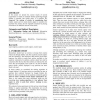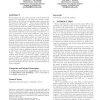111
click to vote
HT
2010
ACM
14 years 10 months ago
2010
ACM
In this poster we present the current results of several experiments in which we analyzed whether spamming Google Scholar is possible. Our results show, it is possible: We ,,impro...
92
Voted
HT
2010
ACM
14 years 10 months ago
2010
ACM
In this paper we present how sharing and utilizing mind maps could enhance search applications such as document search engines and recommender systems. In addition, we briefly pre...
113
Voted
HT
2010
ACM
14 years 10 months ago
2010
ACM
This paper describes a new approach towards detecting plagiarism and scientific documents that have been read but not cited. In contrast to existing approaches, which analyze docu...
113
Voted
HT
2010
ACM
14 years 10 months ago
2010
ACM
In this paper we consider provenance modelling in Adaptive Hypermedia Systems (AHS). We revisit adaptation and data provenance questions and bring up new and complementary aspects...
117
click to vote
HT
2010
ACM
15 years 1 months ago
2010
ACM
Adaptive Hypermedia Systems (AHS) have long been concentrating on adaptive guidance of links between domain concepts. Here we show parallels between navigation and linking in adap...
104
Voted
HT
2010
ACM
15 years 2 months ago
2010
ACM
Online social sharing sites are becoming very popular nowadays among Web users, who use these sites to share their favourite items and to discover interesting and useful items fro...
97
Voted
HT
2010
ACM
15 years 2 months ago
2010
ACM
In this paper we are interested in describing Web pages by how users interact within their contents. Thus, an alternate but complementary way of labelling and classifying Web docu...
125
click to vote
HT
2010
ACM
15 years 2 months ago
2010
ACM
1 Tags are an important information source in Web 2.0. They can be used to describe users’ topic preferences as well as the content of items to make personalized recommendations....
120
click to vote
HT
2010
ACM
15 years 2 months ago
2010
ACM
We investigate the use of autonomically created small-world graphs as a framework for the long term storage of digital objects on the Web in a potentially hostile environment. We ...
95
Voted
HT
2010
ACM
15 years 5 months ago
2010
ACM
Many popular Web 2.0 sites support navigation of tagged web resources. The tag-based navigation has been described as a lightweight reorientation of view on tags and the associate...


